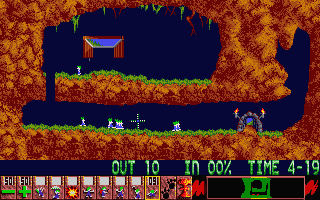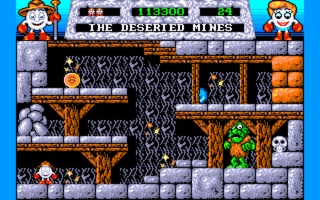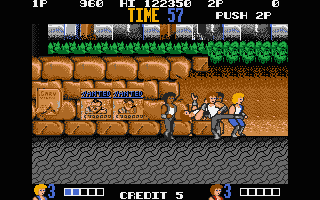Saturday Summaries 2019-03-23: Amiga and Atari ST Gateway Edition
By Mento 0 Comments
With Jeff streaming his MiSTer on Giant Bomb content more frequently these days, and his ever-insatiable curiosity about the Commodore Amiga and Atari ST range of 16-bit computers of the late-80s - the popularity of which was markedly higher outside of the US, particularly Europe - I always find myself wanting to weigh in with my recommendations, as someone who played plenty of both but predominantly the Atari ST. The easy option would be to toss up a list of worthwhile games in a stream request forum thread (I suspect the staff might lean towards making one the next time they have such a stream in the works) or simply point to the games featured in that ST-urday feature I made a few years back.
Instead, I think it's probably more productive to create a general gateway guide to what still holds up, what has aged terribly, and what was never good to begin with.
Safe: "PC" games, those that predominantly use the keyboard and mouse.

My first piece of advice when delving into the Amiga/ST libraries is to treat them like enhanced versions of DOS-era IBM PCs. If there's a particular PC genre that would benefit from better graphics or a meatier processor, the Amiga/ST was the place to go. Keep in mind there's a fairly narrow window here: we're talking about any game released between the launch of the Amiga/ST (1985) and, let's roughly say, the Windows 3.1 era (1992-4) where PCs really started surging ahead of what even the 1MB models of the Amiga/ST could manage. I'm no tech expert today, let alone back in my pre-teens, so I couldn't say for sure when the writing was on the wall for the Amiga/ST - I just recall one day hearing about a fascinating multiplayer artillery game called Worms that had no Atari ST port in its future, and I figured the old girl's time had come.
The games we're talking about here, then, are CRPGs (Might & Magic, Dungeon Master, the Gold Box series), graphic adventure games (King's Quest, The Secret of Monkey Island, Maniac Mansion), strategy games (Dune, North & South, Mega-lo-Mania), and simulation games (SimCity, Frontier: Elite II, Theme Park). There's also a few miscellaneous action games like Lemmings or Cannon Fodder that were built with keyboard and mouse controls in mind. Depending on how far into the early '90s you go, the Amiga/ST versions began superior to the PC versions before the reverse eventually became the case. Generally speaking, though, as long as you aren't getting into CD-ROM territory you're golden as far as Amiga/ST ports go.
Risky: Action games, specifically those that are Amiga/ST exclusive or built with those computers in mind.
The UK game development scene was, for the longest time, a place where anyone with the moxie and means to throw some code together in their bedrooms or studies could make a career out of it. Most of the Amiga/ST's system-exclusive games were those created here or elsewhere in Europe where those computers saw most of their success. That also means that most of them lacked a certain amount of polish, as games were far more of an enthusiast cottage industry back then.

I think what best typifies this category are the Dizzy games, created by the Oliver Twins and published by the Warwickshire-based Codemasters. The majority of them are platformer/adventure hybrids, where you had item puzzles to solve but also had to make your way across various platforming challenges to get from point A (where the item was) to point B (where it could be used). The games suffered from some stringent limitations: for one, Dizzy could rarely carry more than two or three objects at a time, and once the player's finite supply of lives ran out they had to start over. All the same, the silly humor and bright visuals and clever puzzles of the series meant they sold well enough to prompt many sequels, and we eventually saw eight core entries of the classic "adventure" mold, as well as a few more arcade-like spin-offs including Fast Food Dizzy (a Pac-Man clone where the targets were sentient food items), Kwik Snax (a block-pushing game which was more like Adventures of Lolo or Sokoban) and Bubble Dizzy (an action game where you ride bubbles to the surface before your oxygen runs out). I know the UK Dizzy phenomenon has frequently stumped Jeff, but we found its combination of open-world exploration, platforming, puzzle-solving, and collectathons irresistible at the time and looked forward to every new one.
Other avenues here include the James Pond series, Prince of Persia, Out of this World, Turrican, Xenon, Wizball/Wizkid, Rick Dangerous, Speedball, Shadow of the Beast, or Psygnosis's many picturesque shoot 'em ups. All well-regarded in their day, if perhaps a little dated now and especially without the benefit of nostalgia goggles.
It's worth noting that the Atari ST joystick was the same model as those used for previous Atari consoles, going back to the 2600. That is, eight directions and a single fire button. More elaborate action games often had to think outside the box to integrate more commands with these two inputs, adding extra functions for when the fire button was held down, when the joystick was waggled quickly back and forth, and when the fire button and joystick were used simultaneously. It never worked as well as you'd hope, especially for games with more elaborate control schemes like Street Fighter II. Basically, if they had a Genesis/SNES port, I'd go with that version 9 times out of 10.
Danger: Arcade ports and licensed games.

If you want a quick laugh, it's worth booting up the Atari ST version of Double Dragon to see how badly it was handled. That said, there were some competent arcade ports out there: Bubble Bobble, Joust, The Ninja Warriors, Gauntlet, The NewZealand Story, Arkanoid, Rainbow Islands, or really anything from Taito or Atari themselves were competent enough. Just... keep in mind that most aren't. Capcom or Sega rarely fared all that well, for instance, as most of those ports were handled by UK studios who didn't have the chops to replicate the strengths of the source material.
I feel like "licensed games are bad" is more of a universal axiom than anything specific to the Atari ST and Amiga, but the temptation when scrolling through an unfamiliar library is to stop on any name you might recognize, whether it's a game made more famous on other systems or one that is based on a well-known movie, TV, or comic book property. The vast majority of licensed games were quickie platformers from major publishers like Ocean that weren't worth the magnetic tape they were written on.
Keeping all this in mind, feel free to explore the enormous Atari ST/Amiga libraries to your heart's content. Even if the names don't give you much of an indication, it should be obvious enough upon booting it up which of the three above general categories it falls into. That isn't to say every mouse-driven CRPG is good or that every arcade conversion is bad, but it's a more reliable litmus than most. Despite trying to bridge the gap between computers and home consoles to a similar extent as the Commodore 64 and Atari 8-bit models that preceded them, the Amiga/Atari ST family was invariably better in the former role with graphically lush renditions of classic DOS/CGA-era games. Conversely, with only one face button and a not always reliable analog stick, it struggled with most action games in comparison to consoles of the era like the NES and Genesis. Still, one guy's opinion and all that.
Time to get a little more contemporary now with what I've been blogging about this week:
Odallus: The Dark Call
The Indie Game of the Week was this retro banger from 2015, from Oniken developers JoyMasher. It takes the slightly more conventional route of other throwbacks by turning the game into a spacewhipper, albeit one with a traditional stage-based model. While the Castlevania comparison is the most immediately astute - the game shares its sense of the macabre and a warrior protagonist with a few sub-weapons up his sleeves - I found it had more in common with Capcom's Demon's Crest. Demon's Crest, like the Gargoyle's Quest games before it, had this structure where you were regularly encouraged to visit previous stages for power-ups you may have missed the first time due to a lack of the right ability. However, the game could be defeated with simply the starting gear alone if you were skilled enough, and both Odallus and Demon's Crest had a masterful degree of control over their protagonists which made it harder to fault the game for mishaps. Odallus got quite tricky towards the end - I, for one, was glad I went back for all those health upgrades - but its difficulty curve was more gentle than I anticipated. I mean, if I could beat it...
Link here: Indie Game of the Week 112: Odallus: The Dark Call
Warframe
For whatever reason, I embarked on what might prove to be a very long journey into figuring out Digital Extremes's free-to-play, co-op-optional shlooter Warframe. As longtime fans of the game has forewarned, the structure of the game as this persistently updated product has created several additional layers of complexity that could prove to be as alienating to new players as they are intriguing. I've steered away from MMOs for the most part for this very reason: due to my completionist tendencies I prefer games that are built in a specific, static way where there's a clear end and a point where I can put the game down and walk away. I've compared this before to the conundrum of the goldfish and its appetite: if you keep dropping more food into the tank, the fish won't know when to stop and will engorge itself to death.
All the same, I feel like the giddy heights of Warframe are where the shooting moves from competent to transcendental, and the many approbations from those deep into it like GameSpot's Mike Mahardy or Castle Super Beast's (formerly Super Best Friends Play) Pat "AngriestPat" Boivin have frequently given me pause. All this from a game that's completely free? There must be some "fee to pay" catch in the process somewhere, right? That's what I'm doing here with the Seeking Warframe & Fortune series: the goal being to see how far I can delve into the game, its mechanics, and its huge amount of content without paying a cent. Parsimonious, perhaps, and I'm sure it won't win me any points with Digital Extremes themselves who already see plenty of others harping on about the game while also paying good cashola for the privilege of being among the first to discuss a new deluxe warframe or piece of DLC content, but this is the direction I've decided to approach this game as someone who is both skeptical of its late-game appeal and of the idea that no free-to-play is truly free if you're looking for a premium experience. Could be fun being proved wrong though.
Link here: Seeking Warframe & Fortune (Part 1)
Nioh
Yep, still playing Nioh. However, I am at the final boss - or, at least, the final boss of the Japan portion of the game - and don't intend to stick around for too much NG+ besides what I need for the remaining trophies. Nioh has still proven itself to be a fine action-RPG and my continued mastery of all its facets have revealed just how intelligently it was put together.
There are certain side-quests that only open up once you have a certain amount of "affinity" with a weapon type, earned through using those weapons frequently. These weapon types being the standard sword (all-rounder), the axe (slow and heavy), dual-swords (quick but no stopping power), spears (range advantage), and kusarigama (nunchucks with a sickle at the end, used either at close or medium range). Completing these side-quests unlocks the "mystic arts" for those weapons, which are very powerful passive skills, as well as an achievement for each. As such, I've been experimenting with all the weapon types after having mostly stuck to the dual-swords for the entire game; turns out I've been missing a lot. The axe, for instance, is so damn effective against larger and/or armored enemies that it's made tougher or drawn-out fights against the bigger yoki, one-eyes, and onyudos far more of a breeze, even if it's still too slow to properly wield against my speedy nemeses the tengu. The spear is a reliable weapon for human opponents (or human-ish, in the case of revenants) due to catching them with the unexpected range, and the kusarigama has been effective in that role as well. Dual-swords are still the fastest way to dispatch smaller yokai or those low to the ground like skeletons, dwellers (zombies), karakasa umbrellas, and the one-eyed imps. The sword, meanwhile, is effective against any enemy and could alone feasibly carry you through the whole game. In retrospect, it was probably worth learning all this far earlier in.
What I will say is that the game stops pulling its punches, if it was doing so at all in the first place, when you get to the final couple of regions in the game. Throughout, the player's level was approximately the same as the level they were on: these levels determine the stats of the creatures you faced, so it was always beneficial to only attempt stages when you were on a statistical even footing. In the late game, however, levels are increasingly expensive - it now requires a cool half-mil of the game's amrita currency to put mine up any higher - and the stage level settings continue to soar. The final story mission of this particular area I'm in is at level 135: easily 30 levels higher than where I'm at. This means that even regular enemies will plant me in the dirt with a single hit if I'm not careful, and the bosses have only become more deadly between their tougher patterns and insane damage output. Of course, the equipment you find is usually scaled up to the current area's level, so at least I've found some decent gear to mitigate much of the stat disadvantage. Man, though, if it isn't a little discouraging to be one-shotted by some random ogre as I make my way back to the boss fight that just schooled me.
This will be my final update for the game at any rate. I'd highly recommend Nioh; I was initially skeptical about a loot RPG built around a Souls model, but it's proven to be pretty effective and Nioh's sense of atmosphere and approach to lore suggests that Koei Tecmo learned all the right lessons from FromSoftware. It's not the Sengoku-era Souls game everyone is playing right now, but if you ever get tired of Sekiro handing you your own ass there's a marginally easier alternative out there.
